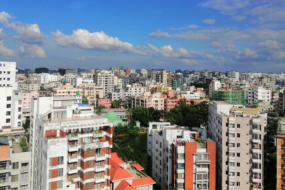Despite headwinds, premium residential real estate is showing a lot of promise, with surging sales, largely driven by the two premier residential markets of Delhi- NCR and Mumbai.
That the premium residential segment is on a high, is clearly evident as residential sales in Q2, 2022, in the RS 1.5 crore above price category shot up by over 270 percent YoY. The two larger markets of Delhi NCR and Mumbai saw maximum sales in the quarter in this price bracket. Apartments priced above Rs 1..5 crores had a share of 15% in the quarterly sales in Q2 2022. The higher levels of residential sales in the premium category show increased demand for bigger homes and buyer confidence coming back to the market. However, apartments in the price bracket between Rs 50 lakh-75 lakh still had a larger share of 28% in the residential sale during the quarter. According to JLL’s Q2 2022 market report, Bengaluru and Pune recorded the majority of the respective city sales in this price category.
Sales of Affordable, Mid-priced, and Premium Homes
| Q2 2021 Sales (units) | Q2 2021 Sales (in %) | Q1 2022 Sales (units) | Q1 2022 Sales (in %) | Q2 2022 Sales (units) | Q2 2022 Sales (in %) | |
| Less Than 50 lakh | 5,347 | 27% | 11,899 | 23% | 13,234 | 25% |
| 50 lakh – 75 lakh | 6,132 | 31% | 17,290 | 33% | 14,904 | 28% |
| 75 lakh – 1 crore | 3,172 | 16% | 11,672 | 23% | 9,505 | 18% |
| 1 crore – 1.5 crore | 2,839 | 14% | 6,187 | 12% | 7,476 | 14% |
| Above 1.5 crore | 2,145 | 11% | 4,801 | 9% | 8,113 | 15% |
| Total | 19,635 | 100% | 51,849 | 100% | 53,232 | 100% |
Source: Real Estate Intelligence Service (REIS), JLL Research
Note: Data includes only apartments. Rowhouses, villas, and plotted developments are excluded from our analysis
Healthy Offtake of Residential Apartments
The residential market recorded sales of over 53,000 units in Q2 2022 which is an increase of 171% Y-o-Y as compared to Q2 2021 across the top 7 cities. This demonstrates the rising demand due to containment of the pandemic and buyer confidence coming back to the market. On a sequential basis, sales increased by 3% during the quarter. Appreciation in residential prices due to rising input costs and interest rates led to almost flat sequential growth in Q2 2022. Mumbai is the largest contributor to sales (23%) followed by Bengaluru with 21% and Delhi NCR with 19% of the overall sales.
City Wise Sales
| Q2 2021 (units) | Q1 2022 (units) | Q2 2022 (units) | Q-o-Q Growth (%) | Y-o-Y Growth (%) | |
| Bengaluru | 3,500 | 12,202 | 11,250 | -8% | 221% |
| Chennai | 600 | 3,450 | 1,553 | -55% | 159% |
| Delhi NCR | 2,440 | 8,633 | 10,076 | 17% | 313% |
| Hyderabad | 3,157 | 4,012 | 5,537 | 38% | 75% |
| Kolkata | 578 | 3,806 | 3,947 | 4% | 583% |
| Mumbai | 5,821 | 11,648 | 12,165 | 4% | 109% |
| Pune | 3,539 | 8,098 | 8,704 | 7% | 146% |
| India | 19,635 | 51,849 | 53,232 | 3% | 171% |
Source: Real Estate Intelligence Service (REIS), JLL Research
Note: Mumbai includes Mumbai city, Mumbai suburbs, Thane city, and Navi Mumbai
Data includes only apartments. Rowhouses, villas, and plotted developments are excluded from our analysis
Another 6,013 residential units in the plots and villa categories were sold during Q2 2022 across the top seven cities. The majority of the traction was seen in the southern cities of Bengaluru, Chennai, and Hyderabad.
Strong Recovery in Sales
India’s residential market has shown remarkable resilience in the last year. Sales of more than 105,000 units were recorded in H1 2022 which is an increase of 119% Y-o-Y as compared to H1 2021. This certainly indicates that the market sentiments are improving compared to the previous year. Sales got a boost from many factors including lower COVID-19 cases, pick up in economic activity, and a stable employment scenario. The residential market has charted a new path of growth in H1 2022, according to Siva Krishnan, Head – Residential, India, JLL.
| H1 2021 | H1 2022 | Growth (%) | City % share in H1 2022 sales | |
| Bengaluru | 8,716 | 23,452 | 169% | 22% |
| Chennai | 3,800 | 5,003 | 32% | 5% |
| Delhi NCR | 7,888 | 18,709 | 137% | 18% |
| Hyderabad | 6,866 | 9,549 | 39% | 9% |
| Kolkata | 1,898 | 7,753 | 308% | 7% |
| Mumbai | 11,600 | 23,813 | 105% | 23% |
| Pune | 7,219 | 16,802 | 133% | 16% |
| India | 47,987 | 105,081 | 119% | 100% |
Source: Real Estate Intelligence Service (REIS), JLL Research
Note: Mumbai includes Mumbai city, Mumbai suburbs, Thane city, and Navi Mumbai
Data includes only apartments. Rowhouses, villas, and plotted developments are excluded from our analysis
Price Appreciation
The increase in input costs and the strong demand has caused an appreciation in residential prices with capital values showing a 3-7% Y-o-Y increase across all cities except Hyderabad which showed resilience by clocking double-digit price growth over the same period “Developers have partially passed on the input cost increases which are now reflected in the current residential prices. New launches also entered the market at higher prices. With interest rates in an upcycle, costs for owning a house are likely to increase further. This may cause some short-term deflation in demand but with changing dynamics around home ownership and with interest rates still on the lower side, residential demand is likely to remain on its growth trajectory, according to Dr. Samantak Das, Chief Economist, and Head Research & REIS, India, JLL.
New Launches on Rise
New launches of more than 63,000 units were recorded in Q2 2022, an increase of 6% Q-o-Q and 135% Y-O-Y. Mumbai dominated with a 27% share in the new launches followed by Hyderabad and Pune which contributed 25% and 21% respectively. Quarterly launches were higher on a Q-o-Q basis in Delhi NCR, Hyderabad, Mumbai, and Pune. It saw a declining quarterly trend in Bengaluru, Chennai, and Kolkata.
City Wise New Project Launches
| Q2 2021 (units) | Q1 2022 (units) | Q2 2022 (units) | Q-o-Q Growth (%) | Y-o-Y Growth (%) | % share in Q2 2022 | |
| Bengaluru | 4,833 | 13,795 | 10,000 | -28% | 107% | 16% |
| Chennai | 392 | 2,403 | 1,384 | -42% | 253% | 2% |
| Delhi NCR | 1,048 | 2,576 | 3,010 | 17% | 187% | 5% |
| Hyderabad | 10,980 | 12,648 | 15,697 | 24% | 43% | 25% |
| Kolkata | 206 | 3,216 | 2,978 | -7% | 1346% | 5% |
| Mumbai | 6,143 | 16,289 | 17,505 | 7% | 185% | 27% |
| Pune | 3,455 | 9,380 | 13,095 | 40% | 279% | 21% |
| India | 27,057 | 60,307 | 63,669 | 6% | 135% | 100% |
Around 8,056 units were also launched across the top seven cities of India in the plots and villa segments in Q2 2022. These projects also recorded good responses from the buyers.
Unsold Inventory Moves Up
In Q2 2022, unsold inventory across the seven cities increased by 2.1% on a Q-o-Q basis as new launches outpaced sales. Mumbai, Delhi NCR, and Bengaluru together account for 60% of the unsold stock. An assessment of years to sell (YTS) shows that the expected time to liquidate the stock has declined from 4.2 years in Q1 2022 to 3.6 years in Q2 2022, an indication of robust sales growth.
Sales penetration -defined as % of apartments sold versus total available inventory is a marker of how markets actually performed on a normalized basis, accounting for varying levels of unsold inventory across all cities. Compared to this metric, the sales penetration for H1 2022 was at an average of 18% at a pan-India level. When looking at individual cities, sales penetration was highest in Pune (28%) with Bengaluru and Kolkata (21%) jointly finishing second. Both Pune and Kolkata are smaller markets in absolute sales terms of apartments, but they perform much better on a normalized comparison when sales penetration is considered. Rising inventory levels amid improving sales need to be looked at as well, when analyzing sales performance across cities.
Outlook:
Developers have partially passed on the rising input cost to the buyers and also there has been an increase in interest rates. As a result, there may be some cooling down of sales in the short term. However, successful containment of the pandemic, improved buyer sentiments, and strong fundamentals of the residential market will lead to an upward trajectory in both launches and sales in the medium to long term. Only credible developers, who are customer-centric and possess proven execution capability, as well as quality products, will survive and emerge stronger.



